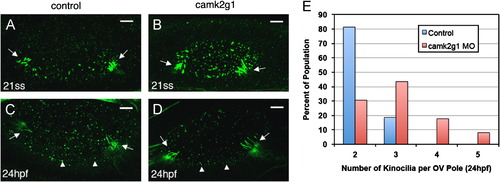FIGURE
Fig. 4
Fig. 4
|
Motile cilia and kinocilia form in camk2g1 morphants. Control (A, D) and camk2g1 morphants (B, D) were labeled with anti-acetylated tubulin (green) at 21ss and at 24 hpf. Kinocilia formed in the proper locations (arrows) emerging from hair cells at the anterior and posterior poles of the otic vesicle. Anterior is to the left. Scale bars=5 μm. A histogram of the number of kinocilia per otic vesicle (OV) pole at 24 hpf (E) revealed a shift in morphant embryos (n=43) to higher values when compared to control embryos (n=62). |
Expression Data
| Antibody: | |
|---|---|
| Fish: | |
| Knockdown Reagent: | |
| Anatomical Term: | |
| Stage Range: | 20-25 somites to Prim-5 |
Expression Detail
Antibody Labeling
Phenotype Data
| Fish: | |
|---|---|
| Knockdown Reagent: | |
| Observed In: | |
| Stage: | Prim-5 |
Phenotype Detail
Acknowledgments
This image is the copyrighted work of the attributed author or publisher, and
ZFIN has permission only to display this image to its users.
Additional permissions should be obtained from the applicable author or publisher of the image.
Reprinted from Developmental Biology, 381(1), Rothschild, S.C., Lahvic, J., Francescatto, L., McLeod, J.J., Burgess, S.M., and Tombes, R.M., CaMK-II activation is essential for zebrafish inner ear development and acts through Delta-Notch signaling, 179-88, Copyright (2013) with permission from Elsevier. Full text @ Dev. Biol.

